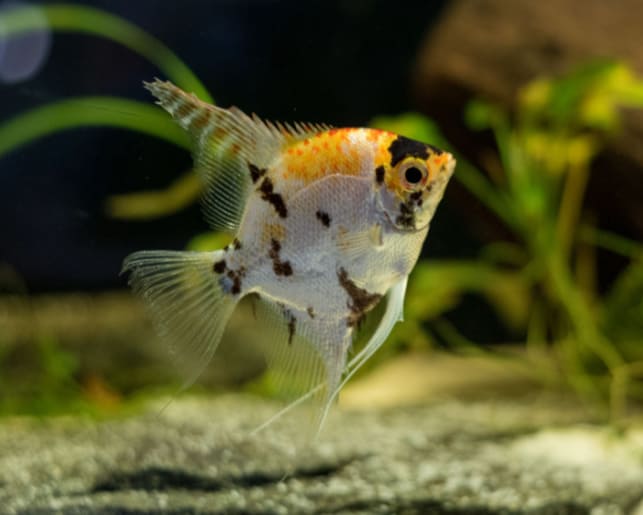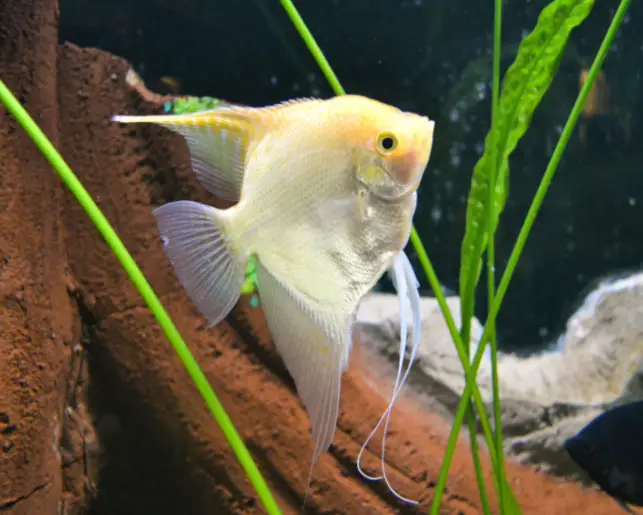Angelfish are always a popular choice for aquarium lovers, favoured for their bright colours and general hardiness. They’re excellent options for intermediates and experts alike, but, regardless of your experience, it’s important to understand their behaviour to give them the best possible care. If your angelfish is suddenly spending a lot of time at the bottom of the tank, this could signify something that needs your attention.
Angelfish can stay at the bottom of the tank due to illness, stress, or pregnancy. This behaviour can also signify that your tank isn’t the best environment for your fish. Staying near the bottom of the tank may be a sign that you need to perform a water change or adjust the temperature.
The rest of this article will tell you everything you need to know about bottom-dwelling angelfish, so you can better understand what this behaviour means and how to address the different problems it can signify.

Why Is My Angelfish Lying at the Bottom of the Tank?
Here are some reasons why your angelfish might be lying at the bottom of the tank:
- Your fish has a swim bladder infection. Fish have an organ called a swim bladder that controls their buoyancy and ability to swim properly. Unfortunately, swim bladder infections are common. If your fish is swimming strangely, upside down, or unable to swim to the top of the tank, they might be suffering from an infection.
- Your angelfish is suffering from ich or another illness. If your angel is frequenting the lower section of its tank, this can mean that your fish is sick and needs treatment as soon as possible.
- The tank needs to be cleaned. A dirty tank can make your fish sick. This is why it’s important to make frequent water changes.
- Temperature adjustments may need to be made. If your fish is too hot or too cold, it might spend less time being active and more time near the bottom.
- An aggressive tank-mate has injured your fish. An injured fish might not be able to swim regularly.
- Your angelfish is being picked on by another fish in the tank. If your fish is being targeted by another fish (almost always another angelfish), they will get stressed and will try and find somewhere quiet in the tank to hide away.
- Your angelfish is pregnant. Angelfish can sometimes spend time near the bottom of the tank if they’re pregnant. If you’re concerned that this is the case, the following section covers common angelfish pregnancy signs to look out for.
- The angelfish pecking order has been established, and this fish is at the bottom of it. Angelfish like to establish a pecking order amongst themselves. Those lower down may get bullied by the ones higher up. This could be why they are keeping out of the way at the bottom of the tank.
Do Pregnant Angelfish Stay at the Bottom of the Tank?
Pregnant angelfish do sometimes stay at the bottom of the tank, but this is quite rare as they like to lay their eggs on a vertical surface rather than on the substrate. If your pregnant angelfish is spending a lot of time laying at the bottom of the tank or swimming very close to the substrate, they could just be wanting a bit of time out from the other fish. However, you should keep an eye on them to rule out illness.
But how exactly can you tell if your angelfish is pregnant or not?
How To Tell if Your Angelfish Is Pregnant.
If you think that your angelfish may be pregnant, here are some common pregnancy signs you should look out for:
- Your angelfish is spending lots of time away from the others, apart from her other half. Many angelfish display this behaviour during pregnancy. You will notice the male is more protective than usual as well.
- Your angelfish is visibly more prominent than normal. If you notice that your angelfish looks a bit plumper than usual, this can be a sign that she is carrying eggs.
- Pregnant angelfish may hide more. If you have good hiding places in your tank (as you should), a pregnant angelfish will usually want to keep a distance between herself and the other fish around her. While most will hide with or without babies inside them, more hiding than usual can be a common sign of fish pregnancy.
- Your angelfish is female. I know this sounds a bit stupid, you need to know whether or not your fish is female before making any judgments about pregnancy. This is crucial because if your angelfish is a male, it’s likely that your fish is ill rather than pregnant. This can also signify the need for water adjustments. It is quite hard to tell the difference between a male and female angelfish. I cover the topic in this article.
If you learn better with visuals, this YouTube video by Aquaplanets does an excellent job of showing how to tell whether your angelfish is male or female.
Are Angelfish Bottom Dwellers?
Angelfish aren’t bottom dwellers. While they’re known to have the occasional algae snack, they’re not naturally bottom feeders and should be swimming around the entirety of the tank. Bottom-dwelling fish include loaches, corydoras, plecos and others.
If your angelfish is spending a lot of time at the bottom of the tank, this is considered abnormal behaviour. I have 2 angels and I very rarely see them at the bottom of the tank. They spent most of their time around the middle part of the tank.

Signs of Illness To Look Out For.
Unfortunately, a bottom-dwelling angel might be a sick, or even dying one.
As discussed earlier, angelfish aren’t natural bottom-dwellers like loaches and other common bottom-feeder species. If you’re convinced that your fish isn’t pregnant, it’s essential to check for symptoms of common fish illnesses.
Here are some illnesses and ailments you should check for:
- Ich: Ich is one of the most common illnesses seen in freshwater fish. It’s a parasitic infection that causes white spots to appear on your fish.
- Swim bladder infections: An infected swim bladder can affect your pet’s ability to swim properly.
- Fin rot: Fin rot is relatively easy to diagnose, as you will be able to see visible damage to the fins.
- Poisoning (contaminated water): Unfortunately, it’s all too easy to contaminate the water in your fish tank accidentally. If you use harsh soaps to clean your fish care supplies, the chemicals in the soap can transfer over to your tank. You should also have a designated bucket for water changes to protect your fish from cleaning solutions.
- Chlorine sickness: It’s imperative to ensure that the water in your fish tank is dechlorinated. If you forget this step during cleaning and/or water changes, this can make your fish very sick.
In addition to bottom-dwelling behaviour, here are some signs of illness that you should look out for:
- White spots (ich)
- Slowed movements
- Rotted fins
- Your fish isn’t eating
- Increased or decreased aggression (depending on the typical behaviour of the individual fish)
How To Treat Common Angelfish Illnesses.
If you think your fish is suffering from an illness, it’s crucial to treat your tank properly.
One helpful solution is to carry out a partial water change. I would also test the water. I personally would carry out the water change even if the water parameters are showing as fine.
It is also a good idea to have a quarantine tank in case you need to take a sick fish away from the group. I have written a helpful article on quarantine fish tanks which you can read here.
Do Angelfish Like To Hide?
Angelfish will hide if they have a reason to, like most fish. Hiding places allow your angel to feel safe while getting accustomed to a new tank. They can also serve as shelter, just in case some of the other tank members (usually angelfish) show aggression.
If your fish stays close to the bottom to hide, this is probably nothing to worry about. It’s still a good idea to double-check for symptoms of pregnancy and illness for safety.

Final Thoughts.
Angelfish are always an interesting addition to any community tank because they’re relatively easy to care for. However, no fish is immune to ailments. If your angel is spending a lot of time near the substrate, this can mean illness, stress, pregnancy, or an inadequate environment.
Hopefully, this article has helped you better understand your angels, so you can analyse their behaviour and continue to keep your fish as happy and healthy as possible.


